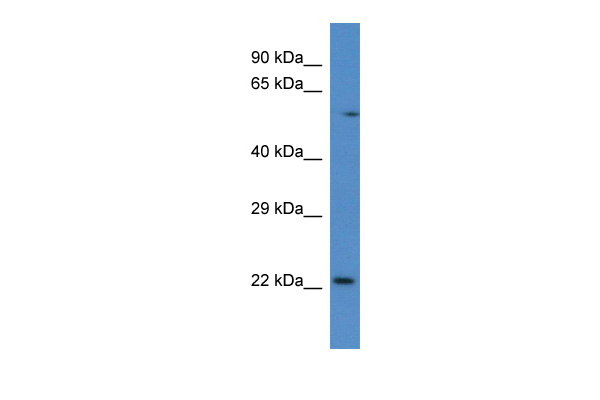Rab10 antibody - C-terminal region
Rabbit Polyclonal Antibody
- 产品详情
- 实验流程
Application
| WB |
|---|---|
| Primary Accession | P61027 |
| Other Accession | NM_016676, NP_057885 |
| Reactivity | Human, Mouse, Rat, Zebrafish, Pig, Dog, Horse, Bovine, Sheep |
| Predicted | Human, Mouse, Rat, Zebrafish, Pig, Chicken, Dog, Guinea Pig, Bovine, Sheep |
| Host | Rabbit |
| Clonality | Polyclonal |
| Calculated MW | 22541 Da |
| Gene ID | 19325 |
|---|---|
| Alias Symbol | AW107754 |
| Other Names | Ras-related protein Rab-10, Rab10 |
| Format | Liquid. Purified antibody supplied in 1x PBS buffer with 0.09% (w/v) sodium azide and 2% sucrose. |
| Reconstitution & Storage | Add 50 ul of distilled water. Final anti-Rab10 antibody concentration is 1 mg/ml in PBS buffer with 2% sucrose. For longer periods of storage, store at 20°C. Avoid repeat freeze-thaw cycles. |
| Precautions | Rab10 antibody - C-terminal region is for research use only and not for use in diagnostic or therapeutic procedures. |
| Name | Rab10 {ECO:0000312|MGI:MGI:105066} |
|---|---|
| Function | The small GTPases Rab are key regulators of intracellular membrane trafficking, from the formation of transport vesicles to their fusion with membranes (By similarity). Rabs cycle between an inactive GDP-bound form and an active GTP-bound form that is able to recruit to membranes different set of downstream effectors directly responsible for vesicle formation, movement, tethering and fusion (By similarity). That Rab is mainly involved in the biosynthetic transport of proteins from the Golgi to the plasma membrane (By similarity). Regulates, for instance, SLC2A4/GLUT4 glucose transporter-enriched vesicles delivery to the plasma membrane (PubMed:17403373, PubMed:22908308, PubMed:27354378). In parallel, it regulates the transport of TLR4, a toll-like receptor to the plasma membrane and therefore may be important for innate immune response (PubMed:20643919). Also plays a specific role in asymmetric protein transport to the plasma membrane (By similarity). In neurons, it is involved in axonogenesis through regulation of vesicular membrane trafficking toward the axonal plasma membrane (By similarity). In epithelial cells, it regulates transport from the Golgi to the basolateral membrane (By similarity). May play a role in the basolateral recycling pathway and in phagosome maturation (By similarity). May play a role in endoplasmic reticulum dynamics and morphology controlling tubulation along microtubules and tubules fusion (By similarity). Together with LRRK2, RAB8A, and RILPL1, it regulates ciliogenesis (By similarity). When phosphorylated by LRRK2 on Thr-73, it binds RILPL1 and inhibits ciliogenesis (By similarity). Participates in the export of a subset of neosynthesized proteins through a Rab8- Rab10-Rab11-dependent endososomal export route (By similarity). Targeted to and stabilized on stressed lysosomes through LRRK2 phosphorylation where it promotes the extracellular release of lysosomal content through EHBP1 and EHNP1L1 effector proteins (PubMed:30209220). |
| Cellular Location | Cytoplasmic vesicle membrane; Lipid-anchor; Cytoplasmic side. Golgi apparatus, trans-Golgi network membrane {ECO:0000250|UniProtKB:P24409}. Endosome membrane {ECO:0000250|UniProtKB:P61026}. Recycling endosome membrane {ECO:0000250|UniProtKB:P24409}. Cytoplasmic vesicle, phagosome membrane {ECO:0000250|UniProtKB:P24409}. Cytoplasm, cytoskeleton, cilium basal body Endoplasmic reticulum membrane Cytoplasm, perinuclear region. Lysosome. Note=Associates with SLC2A4/GLUT4 storage vesicles (PubMed:27354378). Localizes to the base of the cilium when phosphorylated by LRRK2 on Thr-73 (PubMed:20576682, PubMed:27354378). Transiently associates with phagosomes (By similarity). Localizes to the endoplasmic reticulum at domains of new tubule growth (By similarity). Localizes to enlarged lysosomes through LRRK2 phosphorylation (PubMed:30209220). {ECO:0000250|UniProtKB:P24409, ECO:0000250|UniProtKB:P61026, ECO:0000269|PubMed:20576682, ECO:0000269|PubMed:27354378, ECO:0000269|PubMed:30209220} |
| Tissue Location | Expressed in the brain, specifically neurons (at protein level). |
Research Areas
For Research Use Only. Not For Use In Diagnostic Procedures.
Application Protocols
Provided below are standard protocols that you may find useful for product applications.
终于等到您。ABCEPTA(百远生物)抗体产品。
点击下方“我要评价 ”按钮提交您的反馈信息,您的反馈和评价是我们最宝贵的财富之一,
我们将在1-3个工作日内处理您的反馈信息。
如有疑问,联系:0512-88856768 tech-china@abcepta.com.























 癌症的基本特征包括细胞增殖、血管生成、迁移、凋亡逃避机制和细胞永生等。找到癌症发生过程中这些通路的关键标记物和对应的抗体用于检测至关重要。
癌症的基本特征包括细胞增殖、血管生成、迁移、凋亡逃避机制和细胞永生等。找到癌症发生过程中这些通路的关键标记物和对应的抗体用于检测至关重要。 为您推荐一个泛素化位点预测神器——泛素化分析工具,可以为您的蛋白的泛素化位点作出预测和评分。
为您推荐一个泛素化位点预测神器——泛素化分析工具,可以为您的蛋白的泛素化位点作出预测和评分。 细胞自噬受体图形绘图工具为你的蛋白的细胞受体结合位点作出预测和评分,识别结合到自噬通路中的蛋白是非常重要的,便于让我们理解自噬在正常生理、病理过程中的作用,如发育、细胞分化、神经退化性疾病、压力条件下、感染和癌症。
细胞自噬受体图形绘图工具为你的蛋白的细胞受体结合位点作出预测和评分,识别结合到自噬通路中的蛋白是非常重要的,便于让我们理解自噬在正常生理、病理过程中的作用,如发育、细胞分化、神经退化性疾病、压力条件下、感染和癌症。







